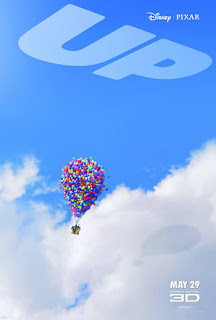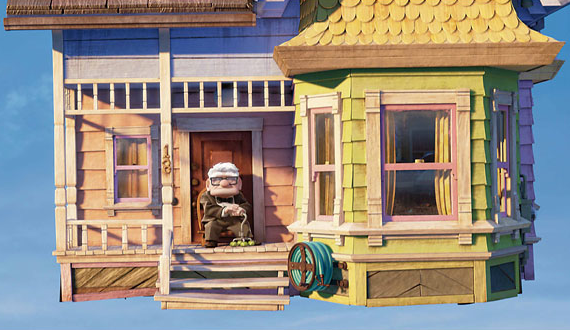 Pixar’s “Up” was the first ever animated film to open the Cannes Film Festival. Though screened out of competition I believe it could have easily won the Palme d’Or. The film mixed up at Skywalker Sound with Michael Semanick and Tom Myers on dialog/music and effects respectively. Myers also shared sound supervising credit with Michael Silvers and the pair both worked on director Pete Docter’s previous feature, “Monsters, Inc.” Riding along with Pixar since 1995’s “Toy Story”, original dialog mixer Doc Kane shot the film’s actors on his ADR stage located at Disney’s Burbank lot. Coffey Sound, a rental house in Los Angeles interviewed the man last year for the Summer edition of their quarterly magazine, “The Coffey Audio Files”. “Up” marked the first film Michael Giacchino composed without Brad Bird directing, Giacchino scored Bird’s last two films “Ratatouille” and “The Incredibles.”
Pixar’s “Up” was the first ever animated film to open the Cannes Film Festival. Though screened out of competition I believe it could have easily won the Palme d’Or. The film mixed up at Skywalker Sound with Michael Semanick and Tom Myers on dialog/music and effects respectively. Myers also shared sound supervising credit with Michael Silvers and the pair both worked on director Pete Docter’s previous feature, “Monsters, Inc.” Riding along with Pixar since 1995’s “Toy Story”, original dialog mixer Doc Kane shot the film’s actors on his ADR stage located at Disney’s Burbank lot. Coffey Sound, a rental house in Los Angeles interviewed the man last year for the Summer edition of their quarterly magazine, “The Coffey Audio Files”. “Up” marked the first film Michael Giacchino composed without Brad Bird directing, Giacchino scored Bird’s last two films “Ratatouille” and “The Incredibles.”
UPDATE: A local Bay Area newspaper reports on the use of police dogs for the sound in “Up”
I wanted to thank foley artists Jana Vance and Dennie Thorpe for the following Q and A.
DS: In terms of cues that the Foley supervisor delivers to the stage, what info is important and helpful for you guys, and what can be left out?
DT: We appreciate all the descriptions we can get. For instance:
- “We’d really like this character’s shoe to have a squeak.”
- “We’re going after a very hyper real feeling in this particular shot so please make sure every creak, squeak, texture and nuance is covered.”
- “Please don’t make the footsteps sound too tappy.”
- “Production sound was great here so we don’t need you to do these particular sounds.”
- “The director really wants this surface to have a deep, heavy sound as well as to play up the texture that is visible.”
- “This creature weighs about 400 pounds–make it heavy, but please also make sure we hear the grit and we want it to sound SCARY.”
Those are just a few examples but that’s the kind of information that help us create a character’s personality and help us to establish the mood of each scene, what elements to play up in the environment, and what elements to play down.
DS: Do you ever have to present “proofs” to sound supervisors for specific sounds?
DT: We definitely present specific sounds or “proofs” for the supervisors and designers to listen to. We generally give them a choice of about four to six different versions. They will NOT know what we used to create the sound or which artist performed it to make sure it’s completely objective and they can concentrate only on the sound. It’s uncanny how often they pick our favorites!
DS: There are a lot of dogs in “Up”; How did you create their footsteps? Did you shoot feet for the dog stampede?
DT: I did Dug, Rotty and the bulldog. The information was that Dug should have NO nails and be friendly and have a soft, padded sound. Rotty and the bulldog could have nails. They weren’t supposed to be as friendly–they were supposed to be more menacing. Their body language also creates their emotional qualities and we support that sonically. We did shoot feet for the dog stampede. We shoot those kinds of scenes working together in a format where we concentrate on the left side of the screen, then the center and then the right. Depending on the shot, we will definitely also concentrate on close, medium and far.
DS: What type of movement or prop usage is the most challenging to shoot? What is the most fun?
DT: Quiet sounds can be challenging. You really want to make sure all the details are distinguishable and correct. They’re often scenes where maybe nothing else is going on and it might be Foley that’s carrying most of it. I like doing hi-tech scenes where someone might be taking something apart very carefully or assembling an intricate mechanism and there are little teeny creaks and slides of components, parts turning, odd scrapes and nervous, twitchy sounds.
Two of the fun things for me, mostly after they’re completed, are gooey, squishy, slimy sounds–they just sound fun even though they make a big mess–and big crashes. The crashes can be very exhilarating.
JV: I think body falls are the hardest. Trying to cheat the weight and boniness of a human body takes a few tries and is physically straining; particularly if there are many to do!
DS: An important trait Foley artist is one who knows how to use his or her instruments of sound creatively. In “Up”, what are a few examples of creative prop usage? (Where the audience would never guess what made the sounds…)
DT: One thing that comes to mind [in terms of creative prop usuage] is Carl’s cane. Sometimes you have to break down a sound since you don’t have the actual prop, particularly if it’s an animation! I held three tennis balls in one hand and a device for a car roof rack in the other. The tennis balls would hit the surface Carl placed the cane on and the roof rack device was the “movement”. Then I used an aluminum walking stick to add to the impact sound on another track; Then a third track for handling. This is very helpful to the mixer because then they’re allowed the freedom to emphasize or de-emphasize the different components a particular sound–in this case the cane. I was very happy to hear the cane almost everywhere Carl used it!
Another example was a toy lawnmower I used as part of the leaf blowing machine Carl used at the beginning of the movie by his mail box.
JV: The effects crew had procured an actual weather balloon somewhere and had passed it on to Foley thinking we might use it for the footsteps and body movements on the Zeppelin. Instead, the giant balloon became a great prop! It became one of the sound components, for the multiple, balloon-string vibrations in the fireplace. It also helped “launch” the tent over the canyon when Russell is trying too hard to put it together. One of the Zeppelin surfaces is a painter’s canvas.
DS: Though Pixar films have had different directors and sound supervisors over the years, their Foley artist has remained the same. With that long of a relationship under your belt, what are some sounds you know Pixar likes to hear in their mixes and what are the sounds you know to avoid?
DT: I’ve been fortunate to work on every Pixar feature. The quality of their work is inspirational because they devote attention and care to every aspect of every single project they get involved with. They want you to dig deep and create a texturally sonic world for their characters to live in. They allow for R&D to make sure everyone involved in the film, i.e., the director, producer, supervisors and designers love the sounds being created. That kind of creative environment only brings out the best in people. There really aren’t any particular sounds to avoid–it’s a matter of making sure all the sounds are appropriate to the entire feel of the project.
DS: What is one of your favorite props? How often have you used it in your films?
DT: Some just get used more than others depending on the need. I’ve found that props are everything in creating good sound effects. I have a collection I’ve been adding to over the years. There are some I won’t loan out or let anyone else use when I’m not there because if they get damaged in any way they’re irreplaceable. All Foley artists have their treasures and they don’t always have a name or a clear use and they almost never look pretty, but they always make good sounds whenever you need them to.
JV: It only becomes a favorite prop if it works! I try to vary my props as much as I can for each movie. I think my favorite prop is my couch which holds me up every night after a day on the stage!
DT: I did Dug, Rotty and the bulldog. The information was that Dug should have NO nails and be friendly and have a soft, padded sound. Rotty and the bulldog could have nails. They weren’t supposed to be as friendly–they were supposed to be more menacing. Their body language also creates their emotional qualities and we support that sonically. We did shoot feet for the dog stampede. We shoot those kinds of scenes working together in a format where we concentrate on the left side of the screen, then the center and then the right. Depending on the shot, we will definitely also concentrate on close, medium and far.


[…] Article source: https://designingsound.org […]